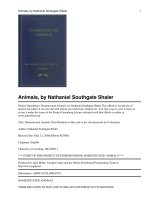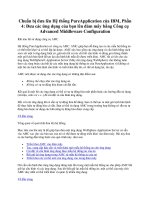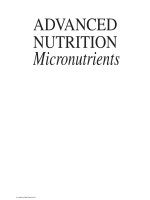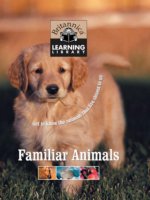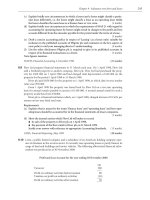T-02 ADVANCED: DIVERSE ANIMALS potx
Bạn đang xem bản rút gọn của tài liệu. Xem và tải ngay bản đầy đủ của tài liệu tại đây (1.48 MB, 13 trang )
Brenda Hoddinott
T-02 ADVANCED: DIVERSE ANIMALS
In this project, you draw a lovable Dalmatian with
realistic eyes and a shiny textured nose, with
emphasis on the forms of her fur and individual
features, as defined by a dominant light source.
Curriculum is designed to enhance skills with: drawing a detailed outline within a complex grid;
identifying accurate proportions; planning shading strategies; rendering the forms of a dog’s
cranial and facial anatomy; and shading graduated values with crosshatching and hatching.
A complex grid (optional) helps you to identify the proper placement of the outlines of various
parts of your drawing subject. However, if you are comfortable drawing a complex subject
freehand, please ignore the references to a grid in this lesson.
This project is divided into the following three sections:
TIPS FOR WORKING WITH A GRID: You use careful observation of spaces and lines
within individual squares to measure for accurate proportions.
DRAWING THE OUTLINE: You draw a detailed outline of Shadow within your
drawing space in preparation for adding shading.
SHADING SHADOW: Hatching is used to add a furry texture, and enhance the three-
dimensional forms of the understructures of her head and neck. Crosshatching works well
to bring out the texture of her collar. Squirkling provides a realistic texture to her nose.
Suggested drawing supplies include 2H, HB, 2B, 4B and 6B pencils, vinyl and kneaded erasers,
sandpaper block, ruler (if you choose to work with a grid), and good quality drawing paper.
13 PAGES – 20 ILLUSTRATIONS
This lesson is recommended for artists and aspiring artists, from age 12 to adult with good
drawing skills, including the shading techniques used for hatching fur. The curriculum of this
lesson is easily implemented into instructional programs for home schooling, academic and
recreational learning environments.
Published by Hoddinott Fine Art Publishers, Halifax, NS, Canada - 2007
Copyright to all articles, images, text, projects, lessons and exercises within this drawing class belong to Brenda Hoddinott and may not be reproduced or used for
any commercial purposes whatsoever without the written permission of Brenda Hoddinott.
Web sites and
2
Press very lightly with your pencil as
y
ou draw the
g
rid lines and
outlines (contour lines) of the dog’s head. All grid lines and some outlines will need to
be erased later. Pressing too hard can also damage the tooth of the paper.
I used an HB mechanical pencil, and onl
y
the wei
g
ht of the pencil itself created the
lines. My scanner software has darkened my grid lines and outline so you can see
them; in fact, my lines are so faint they are barely visible.
TIPS FOR WORKING WITH A GRID
A grid, an invaluable drawing tool to help set up accurate proportions, necessitates careful
observation of spaces and lines within individual squares. A grid is a framework of vertical and
horizontal reference squares on an image and/or drawing paper, used by artists to either enlarge
or reduce the size of the original image. Proportion is the relationship in size of one component
of a drawing to another or others.
Keep the following in mind as you work your way through this project:
Focus on only one square at a time and pretend this one square is the total drawing.
As you draw, don’t think about what the subject is.
Focus on the shapes, and negative and positive spaces that define the actual lines.
Examine the outlines and their positions within the perimeter of this one square.
Note the shape of the spaces on either side of each line.
Observe whether the lines are straight, curved or angular.
Take note of the directions in which curved lines bend, and the length and angle of
straight lines in relation to the sides of this particular square.
Take note of the areas where curved lines meet straight lines.
Shape refers to the outward outline of a form. Basic shapes include circles, squares and triangles.
Negative space refers to the background around and/or behind a drawing subject such as objects,
people, or animals. Positive space refers to the space occupied by the drawing subject and/or its
(or his or her) various parts. Curved lines are created when a straight line curves (or bends).
DRAWING THE OUTLINE
Throughout this section you draw a detailed outline of Shadow within a square drawing space in
preparation for adding shading. Drawing space (also called a drawing surface or a drawing
format) is the area in which you render a drawing within a specific perimeter. It can be the shape
of the paper or outlined by any shape you draw, such as a square, rectangle, or circle.
Contour lines are created when the shared edges of spaces and/or objects meet. Contour lines can
define complete objects or small sections or details within drawing subjects.
Copyright to all articles, images, text, projects, lessons and exercises within this drawing class belong to Brenda Hoddinott and may not be reproduced or used for
any commercial purposes whatsoever without the written permission of Brenda Hoddinott.
Web sites and
3
FIGURE 2-01
Use a
sandpaper block to
keep the point of
your pencil freshly
sharpened. Take
your time, and check
your proportions
often. If you
accidentally draw
something in the
wron
g
square, simpl
y
erase and redraw it.
FIGURE 2-02
1. Use a ruler to lightly
render a square
drawing format.
Mine is 7 by 7 inches, but
feel free to do a larger
drawing by using larger
squares.
2. Draw the grid, using
numbers along the top
and letters down the
side.
This grid has 49 squares,
7 across by 7 down. The
numbers and letters help
you keep track of where
you are working within
the grid.
3. Draw the basic outline
of the head and ears
very lightly with your
HB pencil.
Copyright to all articles, images, text, projects, lessons and exercises within this drawing class belong to Brenda Hoddinott and may not be reproduced or used for
any commercial purposes whatsoever without the written permission of Brenda Hoddinott.
Web sites and
4
FIGURE 2-03
Examine the close-up
section of an oil
painting (by me) in
Figure 2-04, and a
photograph taken by
my daughter, Heidi, in
Figure 2-05. Shadow
has unusual eyes for a
dog; one iris is blue
and the other is
brown.
FIGURE 2-04 FIGURE 2-05
4. Draw the
outline of
the neck
and
collar.
5. Add the
small
section of
her back
that is
visible.
6. Draw the
inside
flaps of
her ears.
7. Draw circles as the outlines of the irises of her eyes (Refer to Figure 2-06).
The iris of an eye is the large colored circular shape.
Copyright to all articles, images, text, projects, lessons and exercises within this drawing class belong to Brenda Hoddinott and may not be reproduced or used for
any commercial purposes whatsoever without the written permission of Brenda Hoddinott.
Web sites and
5
FIGURE 2-06
8. Add triangular shapes as the inner corners of her eyes.
A very tiny section of the white of the eye is visible within this tiny triangle. The white of
the eye (sometimes called the eyeball) is the largest spherical section of the eye that is light
in value but not really white.
9. Draw her nose and mouth.
10. Draw the smallest circles that will be the highlights, the partial circles that indicate
the pupils of the eyes, and the details of the collar (refer to Figure 2-07).
Copyright to all articles, images, text, projects, lessons and exercises within this drawing class belong to Brenda Hoddinott and may not be reproduced or used for
any commercial purposes whatsoever without the written permission of Brenda Hoddinott.
Web sites and
6
FIGURE 2-07
A highlight is the brightest area of an object; usually, the section that is closest to the light
source. The pupil of an eye is the dark circular shape, within the iris, that adjusts its size under
different lighting conditions.
Light source refers to the direction from which a dominant light originates. In this portrait of
Shadow, the light source is from the right front, so the overall shading is lighter on the right.
Also, cast shadows will be added to her neck and the side of her nose resulting from this light
source. A cast shadow is a dark area on a surface, adjacent to where the light is blocked by an
object. This light source will also affect where I place the values in her eyes and on her nose.
When you’ve finished drawing the detailed sections, take a moment to check carefully that
everything is in the correct place, and drawn the right size in relation to the grid lines. Erase and
modify any sections you aren’t happy with.
Copyright to all articles, images, text, projects, lessons and exercises within this drawing class belong to Brenda Hoddinott and may not be reproduced or used for
any commercial purposes whatsoever without the written permission of Brenda Hoddinott.
Web sites and
7
FIGURE 2-08
Don’t forget to erase your grid lines before you begin adding shading!
Then, redraw all sections of the outline that were accidentally erased.
Use the ed
g
e of
y
our vin
y
l eraser to erase the lines and then ver
y
li
g
htl
y
brush awa
y
the eraser crumbs with a soft paintbrush. After that, use
y
our kneaded eraser to
g
entl
y
pat the paper surface to pick up any remaining eraser crumbs.
SHADING SHADOW
There are many ways to add shading to a drawing. I am right-handed and prefer to start my
shading in the upper left hand corner, and work my way across and down the page so as not to
smudge my completed sections.
11. Using a 2B pencil for the darker areas and a HB for the lighter values, add the
shading to the left side of the drawing, beginning in the upper left corner.
The background is done with hatching. A helpful hint for drawing parallel hatching lines is
to use a ruler to lightly draw a few parallel diagonal guidelines before you add shading.
As a right-handed
person, my natural
hand movement is
from the lower left to
the upper right.
The hatching lines in
this background are
rendered from the
lower right to the
upper left, as a left-
handed person would
naturally be inclined
to draw them.
Hence, I had to turn
my drawing sideways
so I could take
advantage of my
natural hand
movement as I added
shading to the
background.
Copyright to all articles, images, text, projects, lessons and exercises within this drawing class belong to Brenda Hoddinott and may not be reproduced or used for
any commercial purposes whatsoever without the written permission of Brenda Hoddinott.
Web sites and
8
FIGURE 2-10 FIGURE 2-09
FIGURE 2-11
12. Add shading to the
ear on the left.
The hatching lines
curve in various
directions.
13. Add shading to the
dark shadow
sections inside this
ear.
14. With your HB
pencil, add
shading to the top
of the head.
The hatching lines
are curving in
various directions
around the forms
and are different
lengths and values.
Curved hatching lines are integral to rendering the forms of the cranial and facial bone structures.
Examine the
values of
this fur, and
take note
that the
white paper
is showing
through in
some
sections.
Also the
overall
values are
darker on
the left.
Copyright to all articles, images, text, projects, lessons and exercises within this drawing class belong to Brenda Hoddinott and may not be reproduced or used for
any commercial purposes whatsoever without the written permission of Brenda Hoddinott.
Web sites and
9
FIGURE 2-12
FIGURE 2-13
FIGURE 2-14
15. Draw the spots on the top of the head and add the fur around her eyes.
16. Use your 2B pencil to darken some areas around the perimeter of the eyes and some
of the spots on the left of the drawing.
17. Shade in the irises and
the whites of the eyes.
Refer to Figure 2-13.
The shading of the irises
is darker under the upper
eyelid and on the side
where the highlight is
drawn.
Conversely, the side of
the iris opposite the
highlight is lighter.
Leave the highlights
white.
Don’t forget to add
shading to the inner
corners (the whites).
18. Add more
background
shading on the top
of the drawing
19. With your HB
pencil, add middle
values to the ear
on the right.
Copyright to all articles, images, text, projects, lessons and exercises within this drawing class belong to Brenda Hoddinott and may not be reproduced or used for
any commercial purposes whatsoever without the written permission of Brenda Hoddinott.
Web sites and
10
FIGURE 2-16
FIGURE 2-15
FIGURE 2-16
FIGURE 2-17
20. Shade in the
pupils with a
6B pencil.
21. Draw the fur
between and
surrounding
her eyes.
22. Shade in the
middle
section of the
background
on the right.
23. Add darker
shading to her
other ear with
HB and 2B
pencils.
The black spots
are not as dark
on the right as
on the left.
24. Draw the fur
on the center
sections of her
face and snout.
25. Draw the fuzzy outlines of the fur
around her mouth and chin.
26. Draw the fur on the left section of
her neck under the chin.
27. Add shading to this tiny section of
her collar.
Copyright to all articles, images, text, projects, lessons and exercises within this drawing class belong to Brenda Hoddinott and may not be reproduced or used for
any commercial purposes whatsoever without the written permission of Brenda Hoddinott.
Web sites and
11
FIGURE 2-19
FIGURE 2-18
Take a few minutes to compare
your drawing to mine (Figure 2-
23), fix any areas that you’re not
happy with, and sign your name!
28. Finish the shading on her mouth and chin.
29. Add the spotted fur on her neck and back (note the directions in which it grows).
30. Finish the background on the right (it becomes darker closer to the bottom).
31. Use crosshatching to add shading to her collar.
32. Use squirkling to add the
shading on the nose.
33. With your 2B pencil add lots of
dots to represent the texture of a
dog’s nose.
Copyright to all articles, images, text, projects, lessons and exercises within this drawing class belong to Brenda Hoddinott and may not be reproduced or used for
any commercial purposes whatsoever without the written permission of Brenda Hoddinott.
Web sites and
12
FIGURE 2-20
CHALLENGE
There are only three ways to improve your drawing skills… Practice, practice and more practice!
Find a close-up photo of the face of another spotted animal, such as a leopard, giraffe, or cow
and draw a realistic, close-up portrait of him or her. Use the shading techniques taught in this
project. Another challenging option is to draw the close-up view of the face of a giraffe named
Dandy in T-04 Advanced: Diverse Animals.
Copyright to all articles, images, text, projects, lessons and exercises within this drawing class belong to Brenda Hoddinott and may not be reproduced or used for
any commercial purposes whatsoever without the written permission of Brenda Hoddinott.
Web sites and
13
Brenda Hoddinott
As a self-educated teacher, visual artist, portraitist, forensic artist, and illustrator, Brenda utilizes
diverse art media including graphite, technical pen, colored pencil, chalk pastel, charcoal, conté
crayon, and oil paints.
My philosophy on teaching art is to focus primarily on the
enjoyment aspects while gently introducing the technical and
academic. Hence, in creating a passion for the subject matter, the
quest for knowledge also becomes enjoyable.
Brenda Hoddinott
Biography
Born in St. John’s, Newfoundland, Brenda grew up in the small town of Corner Brook. She
developed strong technical competencies with a personal commitment to self directed learning,
and the aid of assorted “Learn to Draw” books. During Brenda’s twenty-five year career as a
self-educated civilian forensic artist, numerous criminal investigation departments have
employed Brenda’s skills, including Royal Canadian Mounted Police and municipal police
departments. In 1992, Brenda was honored with a commendation from the Royal Canadian
Mounted Police, and in 1994, she was awarded a Certificate of Membership from “Forensic
Artists International”.
Her home-based art career included graphic design, and teaching recreational drawing and
painting classes. As supervisor of her community’s recreational art department, Brenda hired and
trained teachers, and designed curriculum for several children’s art programs. In 1998, Brenda
chose to end her eighteen-year career as an art educator in order to devote more time to writing,
drawing, painting, and developing her websites.
Drawspace incorporates her unique style and innovative approach to
curriculum development. This site offers downloadable and printable drawing classes for
students of all abilities from the age of eight through adult. Students of all ages, levels and
abilities have praised the simple step-by-step instructional approach. This site is respected as a
resource for fine art educators, home schooling programs, and educational facilities throughout
the world.
Learn-to-draw books
Drawing for Dummies: Wiley Publishing, Inc., New, York, NY, this 336 page book is available
on various websites and in major bookstores internationally.
The Complete Idiot’s Guide to Drawing People: Winner of the Alpha-Penguin Book of the
Year Award 2004, Alpha - Pearson Education – Macmillan, Indianapolis, IN, this 360 page book
is available on various websites and in major bookstores internationally.
